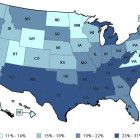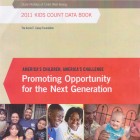
OP-ED: Opening Our Eyes to Uncomfortable Truths
|
Athens, Ga., is a funny town. It’s the home of the University of Georgia, meaning some 35,000 students make their home here for nine months out of the year.
Juvenile Justice Information Exchange (https://jjie.org/tag/poverty/page/2/)

Athens, Ga., is a funny town. It’s the home of the University of Georgia, meaning some 35,000 students make their home here for nine months out of the year.

In prison I could often tell who would be a target for victimization. I developed this ability the old fashioned way, through observation. Predators abound in that world, so opportunities to witness their attacks were common. Whether it was robbery, rape, extortion or some other attempt to dominate those who were on the losing end had often had something in common. According to the convict code the victims were “weak.” This isn’t surprising, since the code was created by those with an interest in perpetuating such crimes.

With the publication of Michelle Alexander’s provocative book, "The New Jim Crow: Mass Incarceration in the Age of Colorblindness," our attention has been drawn to the troubling reality that the majority of young African-American men living in our cities are either incarcerated or on probation or parole. As a result of the ill-conceived “War on Drugs,” our communities of color have been decimated, and a vast population has been left unemployable and disenfranchised. Professor Alexander powerfully demonstrates that America’s racial caste system did not end with the outlawing of state-sanctioned segregation but merely reconstituted itself. With the demise of Jim Crow, the criminal justice system now functions as our society’s system of racial control. Yet, there is an important piece of this picture that has been overlooked.

To date, the Republican presidential candidates have fought their way through 20 debates, collectively fielding 1,037 questions across a broad range of topics. But a new report by Voices for America’s Children shows only a tiny percentage of questions—fewer than 2 percent—focused on child policy issues such as education, child health or child poverty. “While children represent 24 percent of the population and 100 percent of our future,” Bill Bentley, president and CEO of Voices for America’s Children, said in a press release, “questions about their future constituted less than 2 percent of all questions raised in those debates. America’s more than 74 million children can’t vote, but they should be heard, especially in a time of widespread hardship for families.”
The report notes the candidates themselves were more likely to raise children’s issues in their responses than the moderators were in their questions. Only 17 questions addressing education, child health, welfare and poverty were asked of the candidates.

A new formula for calculating who receives food stamps in Kansas has left many U.S.-born children of illegal immigrants without aid. The change affects the Supplemental Nutrition and Assistance Program (SNAP), a federal program administered individually by the states. By law, illegal immigrants are not eligible for food stamps but their U.S.-born children are, according to The Kansas City Star. Previously, Kansas excluded illegal immigrants as members of the household in the formula but adjusted the family’s income proportionately. The new rule doesn’t adjust the income, so a family’s earnings are spread over fewer people in the calculation.

As families continue to struggle during the economic crisis, record numbers of students are receiving free or low-cost school lunches. Department of Education officials reported that 52 percent of fourth graders are now enrolled in the free and reduced lunch program, up from 49 percent in 2009. Last school year, 21 million students received subsidized school lunches, up 17 percent from 18 million in 2006-2007, The New York Times reports. In that same period 11 states saw increases of 25 percent or more as layoffs severely cut into family incomes. The Agricultural Department reports that all 50 states have seen increases in enrollment. Students qualify for free lunches if their families have incomes up to 130 percent of the federal poverty level, or $29,055 for a family of four. In a four-member household with income up to $41,348, children qualify for a subsidized lunch priced at 40 cents.

If you are a child in the United States living in poverty you probably live in the South. According to U.S. census data from 2009 (the last year data are available) the 10 states with the highest rates of child poverty were all in the South. All 10 states had child poverty rates more than 20 percent. In Mississippi, one out of every three children lives in poverty.
A look at teen birth rates reveals a similar cluster. The South is home to all 13 states with the most teen births.
For those who have watched Southern society for many years, the problem is as much cultural as it is economic.
According to Dr. Harvey Jackson, an expert on Southern history and Eminent Scholar in history at Jacksonville State University in Alabama, the statistics are not surprising.
“There are more children in poverty because there are more adults in poverty,” Jackson said. “This is a region of the country in which adults are poor and yet adults continue to have children even though they are poor.”
The problem is social, he says, especially concerning teen births.
“There are real cultural attitudes [in the South] that have to do with large families and premarital sex,” Jackson said. “And it is less condemned in certain communities in the South, particularly among the poor.

For the third year in a row, the Annie E. Casey Foundation’s KIDS COUNT Data Book ranked Georgia 42nd overall. The KIDS COUNT report ranks states by measuring the health and safety of children using a variety of indicators. Georgia ranked in the bottom half of all indicators nationally. The study found 37 percent of Georgia children lived in a single-parent household in 2009, a 1 percent increase from the year before, ranking Georgia 41st in the nation in this category. Georgia saw increases in almost every measurement including:
Children living in poverty (+2 percent)
Children living in families where no parent has full-time, year-round employment (+4 percent)
Teens aged 16-19 not in school and not working (+1 percent)
Teen deaths from all causes (+2 percent)
Only two measurements improved: The teen birth rate declined across all age groups and the number of teens aged 16 to 19 not in high school, who have not graduated fell by one percent.

There has been a significant decline in economic well being for low-income children and families in the last decade, according to the Annie E. Casey Foundation’s annual KIDS COUNT Data Book.
Among the findings, the official child poverty rate, a conservative measure of economic hardship according to the report, increased 18 percent between 2000 and 2009. The increase represents 2.4 million more children now living below the federal poverty line, returning to roughly the same levels as the early 1990’s.
“In 2009, 42 percent of our nation’s children, or 31 million, lived in families with incomes below twice the federal poverty line or $43,512/year for a family of four, a minimum needed for most families to make ends meet,” Laura Speer, associate director for Policy Reform and Data at the Casey Foundation, said in a press release. “The recent recession has wiped out many of the economic gains for children that occurred in the late 1990’s.”

Justice Hines: Single-Parent Households Wreaking Havoc On Georgia Children, Contributing To Criminal Behavior
Texas Educators May Soon Gain Access to Student’s Criminal Records